Scientific classification
Kingdom:
Phylum:
Chordata
Class:
Actinopterygii
Order:
Anguilliformes
Family:
Muraenidae
Genus:
Muraena
Species:
M. Augusti
Binomial name (link Wikipedia)




Black Moray Eel
Murène Noire
Schwarze Muräne
Morena Negra
Zwarte Moeraal
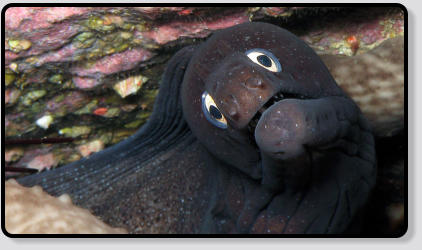
Description
Muraena augusti is a moray eel found north of the eastern Central Atlantic ocean. It was described by Johann Jakob Kaup in 1856, originally
under the genus Thyrsoidea.It is non-migratory, and dwells at a depth range of 0 to 250 metres (0 to 820 ft), most often at around 0 to 50 metres
(0 to 164 ft).

Animalia
Scientific classification
Kingdom:
Phylum:
Chordata
Class:
Actinopterygii
Order:
Anguilliformes
Family:
Muraenidae
Genus:
Gymnothorax
Species:
G. Unicolor
Binomial name (link Wikipedia)




Brown Moray Eel
Murène Brune
Masken Muräne
Murión
Grote Bruine Moeraal
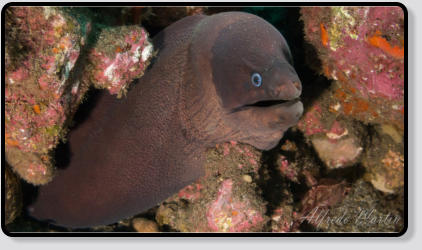
Description
The brown moray, Gymnothorax unicolor, is a moray eel found in the eastern Atlantic Ocean. It was first named by Delaroche in 1809.
Animalia
Scientific classification
Kingdom:
Phylum:
Chordata
Class:
Actinopterygii
Order:
Anguilliformes
Family:
Muraenidae
Genus:
Gymnothorax
Species:
G. Bacalladoi
Binomial name (link Wikipedia)




Canary Moray Eel
Murène Brune
Masken Muräne
Murión
Kleine Bruine Moeraal
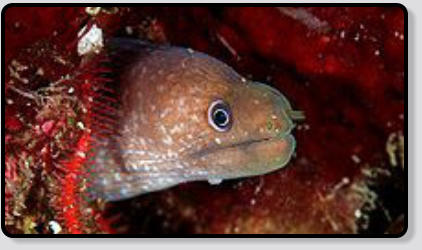
Description
The Canary moray (Gymnothorax bacalladoi) is a moray eel of the family Muraenidae, found only around the Canary Islands in the eastern
central Atlantic, at depths between 17 and 605 m. Its length is up to 35 cm.
Animalia
Scientific classification
Kingdom:
Phylum:
Chordata
Class:
Actinopterygii
Order:
Anguilliformes
Family:
Muraenidae
Genus:
Gymnothorax
Species:
G. Miliaris
Binomial name (link Wikipedia)




Golden-Tail Moray Eel
Murène Dorée
Goldschwanzmuräme
Morena Miliari
Gele Moeraal
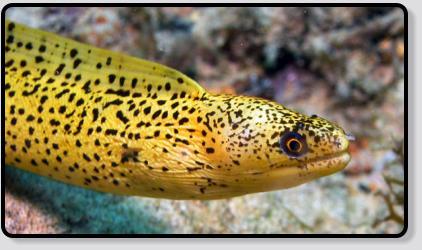
Gymnothorax miliaris, the goldentail moray or conger moray, is a species of marine fish in the family Muraenidae.
The goldentail moray is a medium-sized fish that can reach a maximum length of 70 cm, but the ones usually observed are rather average 40 cm
in length. Its serpentine in shape body has a brown light or dark background color dotted with small yellow spots. These later are smaller on the
head and larger at the tail. The snout and the tail are yellowish. The inside of their mouth is white.
The goldentail moray is widespread throughout the western Atlantic Ocean, including the Caribbean Sea and the Gulf of Mexico, so it is present
from Florida, Bermudas until southeast Brasil.[3][4] Its presence was also reported in the islands from the center of the Atlantic Ocean like Saint
Helena and Ascension but also close to the African coast in the Cape Verde Islands.
It typically lives on rocky and coral reef slopes between the surface and 35 meters (115.5 feet) in depth with a maximum reported at 60 meters
(198 feet).
Description
Animalia
Scientific classification
Kingdom:
Phylum:
Chordata
Class:
Actinopterygii
Order:
Anguilliformes
Family:
Muraenidae
Genus:
Enchelycore
Species:
E. Anatina
Binomial name (link Wikipedia)




Fangtooth Moray
Murène Tigre
Tigermuräne
Bogavante
Tijgermoeraal
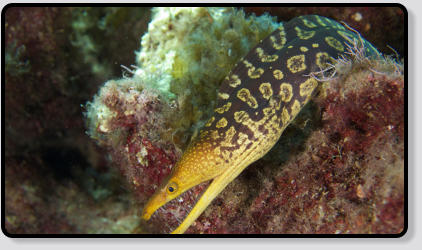
The Fangtooth Moray (sometimes Tiger Moray or Bird-eye conger) is a moray eel of the family Muraenidae found in warmer parts of the eastern
Atlantic Ocean, including the Mediterranean Sea, Canary Islands, Madeira and various other islands.
The Fangtooth Moray is distinctive for its bright yellow colouring and elongated jaw, which is filled with a large number of long "glasslike" teeth. It
can reach up to 120 cm in length.
Description
Animalia
Scientific classification
Kingdom:
Phylum:
Chordata
Class:
Actinopterygii
Order:
Anguilliformes
Family:
Muraenidae
Genus:
Muraena
Species:
M. Helena
Binomial name (link Wikipedia)




Mediterranean Moray Eel
Murène de Mediterranée
Mittelmeer-Muräne
Morena Pintada
Europese Moeraal
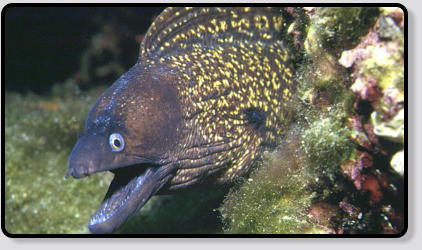
The Mediterranean moray (sometimes also called Roman eel, Muraena helena) is a fish of the moray eel family. It has a long eel-like body and is
found in the eastern Atlantic Ocean and Mediterranean Sea. Its bite can be dangerous to humans.
The Mediterranean moray has an elongated, eel-like body and can reach a length of 1.5 meters and weigh over 15 kilograms. Its coloration
varies from dark grey to dark brown with fine dark spots. The skin is slimy and without scales. The dorsal fin begins behind its head and
continues to the caudal fin (fused with the anal fin). Pectoral fins are absent, teeth are long and sharp-pointed (like other morays), the mouth is
long and robust and reaches behind the gills.
Although snakes and Mediterranean morays are not closely related, the body of the Mediterranean moray is analogous to that of a snake. It is structured
differently but serves the same function. Their bodies of both are flexible for folding or coiling into small places, for example, crevices for the Mediterranean
moray and under rocks for the snake. Both also use their bodies to slither from place to place whether it be in the water or on land. The pharyngeal jaw of
the Mediterranean moray (which is explained above) is also analogous to the snake’s jaw. The right and left jaw of the snake unattach allowing the snake to
eat larger prey than itself successfully. The pharyngeal jaw of the Mediterranean moray uses a different method and has a different structure than the
snake's but the outcome, purpose and advantage are the same. These analogous features have evolved independently of each other as both animals have
adapted to their environment.
Description
Animalia





Harry van Goor 2016
source: Wikipedia, the free encyclopedia


Categories: Eels
Scientific classification
Kingdom:
Phylum:
Chordata
Class:
Actinopterygii
Order:
Anguilliformes
Family:
Congridae
Genus:
Conger
Species:
C. Conger
Binomial name (link Wikipedia)




European Conger Eel
Congre
Meeraal
Congrio
Kongeraal
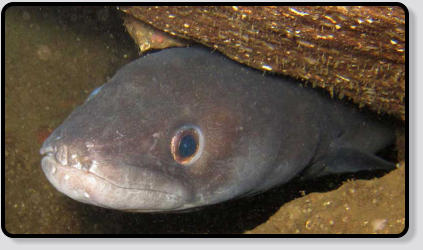
The European conger (Conger conger) is a species of conger of the family Congridae. It is the largest eel in the world and native to the northeast
Atlantic, including the Mediterranean Sea.
European congers have an average adult length of 1.5 m (4 ft 11 in), a maximum known length of 3 m (9 ft 10 in), and maximum weight of
roughly 110 kg (240 lb), making them the largest eels in the world by weight, they can be rivaled or marginally exceeded in length by the largest
species of moray eel but these tend to be more slender and thus weigh less than the larger congers. Average specimens caught will weigh only
2.5 to 25 kg (5.5 to 55.1 lb). Females, with an average length at sexual maturity of 2 m (6 ft 7 in), are much larger than males, with an average
length at sexual maturity of 1.2 m (3 ft 11 in).
The body is very long, anguilliform, without scales. The colour is usually grey, but can also be blackish. The belly is white. A row of small white
spots is aligned along the lateral line. The head is almost conical, and slightly depressed. The snout is rounded and prominent, with lateral
olfactory holes. The large gill openings are in the lateral position. The conical teeth are arranged in rows on the jaws. The dorsal and anal fins are
confluent with caudal fin. Pectoral fins are present, while ventral fins are absent.
Description
Animalia

Scientific classification
Kingdom:
Phylum:
Chordata
Class:
Actinopterygii
Order:
Anguilliformes
Family:
Congridae
Genus:
Heteroconger
Species:
H. Longissimus
Binomial name (link Wikipedia)




Garden Eel
Anguille Jardinière
Röhrenaal
Anguila Jardinera
Zand Paling
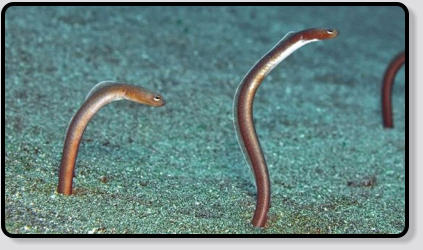
The brown garden eel (Heteroconger longissimus), also known simply as the garden eel, is an eel in the family Congridae (conger/garden eels).
It was described by Albert Günther in 1870. It is a tropical, marine eel which is known from the eastern and western Atlantic Ocean, including
Madeira, the Canary Islands, Senegal, the Bahamas, the Florida Keys, Antilles, Yucatan, Belize, Honduras, and Brazil. It dwells at a depth of 10-
60 m, most commonly between 20 and 60 m, and leads a nonmigratory, benthic lifestyle, inhabiting reefs in colonies. They likely spawn during
the warm season. The larval state of development lasts for about 6-8 months. Adult males can reach a maximum total length of 51 cm.
The brown garden eel's diet consists primarily of detritus and plankton
Description
Animalia

Scientific classification
Kingdom:
Phylum:
Chordata
Class:
Actinopterygii
Order:
Anguilliformes
Family:
Congridae
Genus:
Ariosoma
Species:
A. Balearicum
Binomial name (link Wikipedia)




Bandtooth Conger
Congre de Sable
Goldener Balearen-Meeraal
Congrio de Arena
Zee Paling
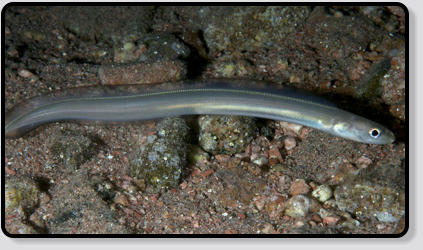
The bandtooth conger (Ariosoma balearicum), also known as the Baleares conger or the Balearic conger, is an eel in the family Congridae
(conger/garden eels). It was described by François Étienne Delaroche in 1809, originally under the genus Muraena. It is a subtropical, marine eel
which is known from the western and eastern Atlantic and the western Indian Ocean, including North Carolina, USA; the northern Gulf of Mexico,
northern South America, Canada, Portugal, Angola, the Mediterranean, and the Red Sea. It inhabits reefs and littoral shelves, and burrows into
sand and mud. It dwells at a depth range of 1-732 metres, but most frequently between 20-100 m. Males can reach a maximum total length of 35
centimetres, but more commonly reach a TL of 25 cm.
The Bandtooth conger is of minor interest to fisheries.
Description
Animalia

Scientific classification
Kingdom:
Phylum:
Chordata
Class:
Actinopterygii
Order:
Anguilliformes
Family:
Ophichthidae
Genus:
Myrichthys
Species:
M. Pardalis
Binomial name (link Wikipedia)




Golden Spotted Snake Eel
Anguille Serpent
Goldflecken-Schlangenaal
Carmetita
Goudaal
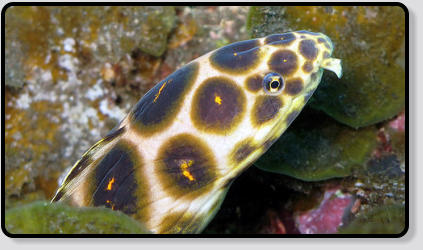
The Leopard Eel or Golden Spotted Snake Eel
The Leopard eel (Myrichthys pardalis) is an eel in the family Ophichthidae (worm/snake eels). It was described by Achille Valenciennes in 1839,
originally under the genus Ophisurus. It is a marine, tropical eel which is known from the eastern Atlantic Ocean, including the Canary Islands;
Annobon Island, Equatorial Guinea; and São Tomé Island. It forms burrows in coarse sand sediments on rocky island coasts. Males can reach a
maximum total length of 64.8 centimetres (25.5 in).
The Leopard eel's diet consists of benthic invertebrates. It is of minor commercial interest to fisheries.
Description
Animalia

Scientific classification
Kingdom:
Phylum:
Chordata
Class:
Actinopterygii
Order:
Anguilliformes
Family:
Nettastomatidae
Genus:
Facciolella
Species:
F. Oxyrhyncha
Binomial name (link Wikipedia)




Sharpnose Sorcerer Eel
Anguille Sorcière
Spitznasen-Zauderaal
Bruja
Toveraal
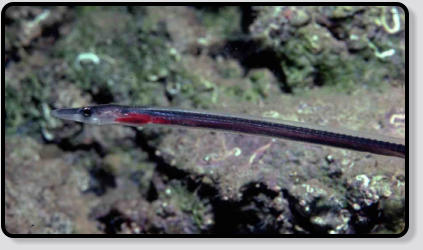
Facciola's Sorcerer or Sharpnose Sorcerer Eel.
The Facciola's sorcerer (Facciolella oxyrhyncha), also known as the Facciola sorcerer in Uruguay is an eel in the family Nettastomatidae
(duckbill/witch eels). It was described by Cristoforo Bellotti in 1883. It is a marine, subtropical eel which is known from the eastern Atlantic Ocean,
including southern Portugal, Angola, and the Ligurian and Tyrrhenian seas. It dwells at a depth range of 30–731 metres; the young are known to
inhabit caves, in which the larger specimens are found deeper. Males can reach a maximum standard length of 64.9 centimetres.
The Facciola's sorcerer's diet consists of decapod crustaceans in the taxon Natantia.
Description
Animalia











